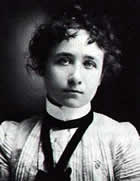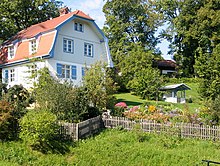Gabriele Münter
Gabriele Münter | |
|---|---|
 Gabriele Münter in 1900 | |
| Born | 19 February 1877 |
| Died | 19 May 1962 (aged 85) |
| Nationality | German |
| Known for | Painting |
| Movement | Expressionism |
Gabriele Münter (Berlin, 19 February 1877 – 19 May 1962) was a German expressionist painter who was at the forefront of the Munich avant-garde in the early 20th century. A student of the painter Wassily Kandinsky, she was a founding member of the expressionist group Der Blaue Reiter.
Early life
Münter was born to upper middle class parents in Berlin. Regardless of the times, her family supported her desires to become an artist. She began to draw as a child. As she was growing up, she had a private tutor, and took classes at the Woman’s Artist School, since she was not allowed to enroll in the German Academies because she was a woman. She didn’t feel challenged by her current school, so she decided to take her studies elsewhere. Both of her parents had died by the time she was 21 years old, and she was living at home with no occupation. In 1898, she decided to take a trip to America with her sister to visit extended family. They stayed in America for over two years, mainly in the states of Texas, Arkansas, and Missouri. Both girls had inherited a large amount of money, allowing them to live freely and independently. Her childhood and early adulthood greatly impacted her future artistic career. She had a free and unrestricted life that was unconstrained by convention. Living in America and Europe had given Münter social exposure that many women did not have at the time. Münter studied woodcut techniques, sculpture, painting, and printmaking. Soon after she began taking classes, Münter became professionally involved with the Phalanx School’s director, the Russian painter Wassily Kandinsky.[1] This eventually turned into a personal relationship that lasted for over a decade.[1] Kandinsky was the first teacher that had actually taken Münter’s painting abilities seriously. In the summer of 1902, Kandinsky invited Münter to join him at his summer painting classes just south of Munich in the Alps, and she accepted.
At first I experienced great difficulty with my brushwork- I mean with what the French call la touche de pinceau. So Kandinsky taught me how to achieve the effects that I wanted with a palette knife... My main difficulty was I could not paint fast enough. My pictures are all moments of life- I mean instantaneous visual experiences, generally noted very rapidly and spontaneously. When I begin to paint, it's like leaping suddenly into deep waters, and I never know beforehand whether I will be able to swim. Well, it was Kandinsky who taught me the technique of swimming. I mean that he has taught me to work fast enough, and with enough self-assurance, to be able to achieve this kind of rapid and spontaneous recording of moments of life.
— Gabriele Münter, Reinhold Heller, Gabriele Münter: The Years of Expressionism 1903-1920. New York: Presteverlag, 1997.
Work
Münter was heavily focused on German Expressionism, however she worked in various mediums. She kept a journal and documented her journeys with a state-of-the-art camera. She was familiar with many of the more famous artists of the time; in one of her journals, she stated that she wanted to learn from the avant-garde artists in France.

In 1901, Münter studied at the Phalanx School, an avant-garde institution founded by Russian artist, Wassily Kandinsky. [2] She began her studies here due to the official art academies in Munich and Düsseldorf being closed off to women. [2] Here, Münter was introduced to Post-Impressionism and the marking techniques of a palette knife and a brush. Her vivid colors and bold outlines were somewhat derived from Gauguin and the Fauves whom she admired. Along with this, Münter was inspired by her Bavarian folk art objects collection and particularly the paintings on glass. [2] Additionally, Münter and Kandinsky's relationship affected Kandinsky's work. Aside from his earlier work, Kandinsky began to adopt Münter's use of saturated colors and abstract expressionist style. Münter and Kandinsky traveled through Europe including the Netherlands, Italy, and France, as well as North Africa.[3] It was during this time that they met Rousseau and Matisse. Münter and Kandinisky fell in love with the small market town of Murnau in southern Bavaria. Later on, Münter bought a house in Murnau and spent much of her life there. Münter and Kandinsky helped establish the Munich-based avant-garde group called the New Artists’ Association (Neue Künstlervereinigung). She contributed to a number of the most significant avant-garde exhibitions in Germany up till World War I.
In 1911 Münter was one of the first artists to exhibit with Kandinsky's German Expressionist group known as Der Blaue Reiter (The Blue Rider). Within the group, artistic approaches and aims varied amongst artists; however, they shared a common desire to express spiritual truths through art. They championed modern art, the connection between visual art and music, the spiritual and symbolic associations of color and a spontaneous, intuitive approach to painting in its move toward abstraction.
Münter was part of a small subgroup of artists active in transforming late Impressionist, Neo-Impressionist, and Jugendstil (or Art Nouveau) painting into the more radical, non-naturalistic art now identified as Expressionism. Early on, Münter developed a great interest in landscapes. Münter's landscape paintings employ a radical Jugendstil simplicity and suggestive symbolism with softly muted colors, collapsed pictorial space and flattened forms.[4] She enjoyed exploring the world of children; using colorful prints of children and toys, Münter shows precision and simplicity of form in her rejection of symbolic content.
By 1908, her work began to change. Heavily influenced by Matisse and Fauvism, Gauguin, and van Gogh, Münter's work became more representative[4] and she took refuge in the small Bavarian market town of Murnau, a village untouched by industrialization, progress, and technology; it was here, in Münter's landscape paintings, that she emphasized nature, imaginative landscapes and an opposition to German modernism.[4] Münter's landscapes are unusual in their use of blues, greens, yellows, and pinks; and color plays a large role in Münter's early works. Color is used to evoke feelings: picturesque, inviting, imaginative, and rich in fantasy. In Münter's landscapes, she presents the village and countryside as manifestations of human life; there is a constant interaction and coexistence with nature.
In 1911, with the establishment of Der Blaue Reiter, Münter's work changed stylistically once again. There is a transition from copying nature more or less impressionistically to feeling its content, abstracting, and drawing out an extract. There grew an interest in painting the spirit of the modern civilization, its social and political turmoil and its gravitation towards materialism and alienation. Münter noted that pictures are all moments of life: instantaneous visual experiences, generally rapid and spontaneous; her paintings each have their own identity, their own shape, and their own function.[5]
For Münter, it is the use of color that expresses these ideas. The German Expressionists moved towards primitive art as a model of abstraction (or non-representational, non-academic, non-bourgeois art.[6] The German artist looked not for harmony of outward appearance, but for the mystery hidden behind the external form. He (or she) was interested in the soul of things, wanting to lay it bare.[4]
Later years

At the end of their relationship, there were a number of images that were returned to Kandinsky, but Münter stored many of the pieces in a warehouse for many years. But once tension started to grip Europe, and condemnation of the modernist movements began to rise, she had all of the art work done by her, Kandinsky, and the other members of the Blaue Reiter transported to her house, where she hid them. In spite of her financial problems, she preserved them with care during the War.[3] Through several house searches, the pieces were never found. On her eightieth birthday, Münter gave her entire collection, which consisted of more than 80 oil paintings and 330 drawings, to the Städtische Galerie in the Lenbachhaus in Munich. After Münter and Kandinsky’s relationship ended, there was a period of inactivity in her art career. She picked up painting again in the late 1920s after she had moved back to Germany with Johannes Eichner after the war.[7] In 1956, Münter received a few awards such as the Culture Prize from the City of Munich. Münter's work was exhibited in the 1960s in the US for the first time and was shown at Mannheim Kunsthalle in 1961. When she was with Johannes Eichner, she still continued to represent the movement. The Gabrielle Münter and Johannes Eichner foundation was established and has become a valuable research center for Münter’s art, as well as the art that was done by the Blaue Reiter group. Münter lived the rest of her life in Murnau, traveling back and forth to Munich. She died at home in Murnau am Staffelsee on 19 May 1962.
Style
Münter is most well known for her landscapes, many of which were painted in Murnau. Her composition and forms are very flat and the colors are muted and suggestive. In the early 1900s her style began to change as a result of the influence of Matisse and Fauvism, Gauguin, and van Gogh. Her paintings became more representative. Color played a large role in her work.[7] She used a number of blues, greens, yellows, and pinks that were very unusual. She also found it important that her figures were as abstract as the rest of her piece. Even though her palette was very bright, there seems to be no happiness.
Notes and references
- ^ a b Hoberg, Annegret, and Long R.-C. Washton. "Wassily Kandinsky and Gabriele Munter." Art Journal. 55.3 (1996): 84. Print.
- ^ a b c Heller, Nancy G. (1987). Women Artists. New York: Abbeville Press. pp. 118–120.
- ^ a b Münter, Gabriele, Annegret Hoberg, Shulamith Behr, and Barnaby Wright. Gabriele Münter: The Search for Expression 1906-1917. London: Courtauld Institute Art Gallery, in association with Paul Holberton Pub, 2005. Print.
- ^ a b c d Heller, Reinhold, Gabriele Münter: The years of Expressionism 1903-1920. New York: Presteverlag, 1997.
- ^ Bachrach, Susan. "A Comparison of the Early Landscapes of Münter and Kandinsky, 1902-1910." Woman's Art Journal 2 no. 1 (1981): 21-24.
- ^ Wye, Deborah, review of Desire in Berlin, by Ian Buruma. The New York Review of Books 55, no, 19 (2008): 1-4.
- ^ a b Opfell, Olga S. Special Visions: Profiles of Fifteen Women Artists from the Renaissance to the Present Day. Jefferson, N.C: McFarland, 1991. Print.
Sources
- Behr, Shulmith, Movements in Modern Art: Expressionism. Cambridge University Press, 1999.
See also
External links
- Works & Biography, Galerie Ludorff, Düsseldorf, Germany
- "German Expressionism" in the 2009 Encyclopædia Britannica Online
- Gabriele Münter profile at the National Museum of Women in the Arts
